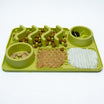Being a stay-at-home mom is a fulfilling and rewarding role, but it also comes with its own set of challenges and responsibilities. One of the top priorities for any parent is ensuring the personal safety and security of their family, and stay-at-home moms are no exception. Creating a safe and secure environment for you and your children is essential for peace of mind and well-being.
In this article, we will explore various measures and strategies that stay-at-home moms can adopt to enhance personal safety within their homes and daily lives. We will cover topics such as assessing and securing your home, personal safety measures, children's safety, managing online safety, creating support networks, and maintaining mental and emotional well-being.
While these tips are valuable for all parents, they are specifically tailored to the unique needs and circumstances of stay-at-home moms. With a little planning, preparation, and the right knowledge, you can create a safe haven for you and your family, where you can thrive and enjoy each day with peace of mind.
So, let's dive in and learn how you can create a secure environment for your family as a stay-at-home mom.
Assessing and Securing Your Home
When it comes to creating a secure environment for stay-at-home moms, assessing and securing your home is crucial. By taking the necessary precautions, you can help ensure the safety of both you and your family. Here are some key areas to focus on when it comes to assessing and securing your home:
Home Security Systems
Investing in a reliable home security system is a great first step towards enhancing the safety of your home. A good security system can provide you with peace of mind by deterring potential intruders and alerting you to any suspicious activity. Some popular options include:
- Wireless alarm systems: These systems are easy to install and can be connected to your smartphone for remote monitoring.
- Surveillance cameras: Installing security cameras around your property can help deter criminals and provide valuable evidence in case of a break-in.
- Smart doorbell cameras: These devices allow you to see and interact with visitors at your front door through your smartphone, adding an extra layer of security.
Doors and Locks
The doors and locks in your home serve as the first line of defense against intruders. It's important to ensure that they are secure and in good condition. Here are a few things to consider:
- Solid doors: Opt for solid doors made of materials like metal or solid wood, as they are more difficult to kick in or break through.
- Deadbolt locks: Install deadbolt locks on all exterior doors, as they provide more resistance against forced entry.
- Door reinforcement: Consider reinforcing your doors with metal plates and strike plates, which can prevent them from being easily forced open.
Windows and Curtains
Windows are another potential entry point for burglars, so it's important to secure them properly. Here are some tips for window security:
- Window locks: Install locks on all windows to prevent them from being opened from the outside. There are various types of window locks available, including sash locks and window wedges.
- Window alarms: Consider installing window alarms that will go off if someone tries to open or break your windows.
- Curtains and blinds: Keep your curtains and blinds closed at night or when you are not at home to prevent people from seeing inside your house.
Securing your home effectively requires a combination of tactics and the use of advanced security technology. By implementing these measures, you can greatly enhance the safety of your home and ensure peace of mind for yourself and your family.
"A safe home is a happy home. Take the time to assess your home's security and make the necessary improvements to protect your loved ones."
Personal Safety Measures
When it comes to personal safety, it's essential for stay-at-home moms to take proactive measures to protect themselves and their homes. While being a stay-at-home mom can be incredibly rewarding, it also means having the responsibility of creating a safe environment for yourself and your family. In this section, we'll explore some practical personal safety measures that you can implement in your daily life.
Creating a Safe Routine
Having a consistent routine can help you feel more in control and secure in your daily life. Here are some important steps to consider:
- Stick to a schedule: Plan out your day, including regular wake-up and bedtime routines, meal times, and playtime. Having a schedule not only helps your children feel secure but also ensures that you have time for yourself.
- Secure your home: Before leaving the house, make sure all doors and windows are locked. It's also a good idea to install a peephole in your front door so you can see who is outside before opening it.
- Notify trusted contacts: Let a trusted neighbor or family member know about your routine and when they can expect to see you. This way, someone will notice if you don't follow your usual schedule.
- Practice situational awareness: Be aware of your surroundings, both inside and outside your home. Pay attention to any suspicious activities or individuals and trust your instincts if something feels off.
Emergency Contact Information
Having emergency contact information readily available is crucial in case of an emergency. Make sure to:
- Create a list: Write down important phone numbers, such as your local police department, fire department, doctor, and emergency contacts. Keep this list in a place that is easily accessible, like on the fridge or in your phone.
- Teach your children: Teach your children how to dial emergency numbers and explain the importance of knowing their address and phone number in case they need to call for help.
Self-Defense Techniques
While we hope you never have to use them, knowing self-defense techniques can provide a sense of empowerment and peace of mind. Consider:
- Taking a self-defense class: Look for local self-defense classes tailored specifically for women. These classes can teach you how to protect yourself in various situations and boost your confidence.
- Learning basic self-defense moves: Practice basic self-defense moves at home, such as strikes, kicks, and escape techniques. You can find tutorials and instructional videos online that can help you get started.
- Carrying self-defense tools: Consider carrying personal safety tools, such as a whistle or pepper spray, for added protection.
Remember, personal safety is about being proactive and prepared. By implementing these personal safety measures into your daily routine, you can create a secure environment for yourself and your family.
"Safety and security don't just happen, they are the result of collective consensus and public investment. We owe our children, the most vulnerable citizens in our society, a life free of violence and fear." - Nelson Mandela
Children's Safety
As a stay-at-home mom, your top priority is the safety and well-being of your children. Creating a secure environment for them is crucial to ensuring their safety at all times. Here are some important measures you can take to keep your children safe:
Babyproofing
Babies are naturally curious and love to explore their surroundings. However, this can sometimes lead to accidents. Babyproofing your home is essential to prevent any harm to your little ones. Here are some babyproofing tips to keep in mind:
- Secure cabinets and drawers - Use childproof locks or latches to keep cabinets and drawers closed and out of reach for your child.
- Cover electrical outlets - Place outlet covers on all electrical outlets to prevent your child from sticking their fingers or objects into them.
- Secure furniture - Anchor heavy furniture, such as bookshelves and TV stands, to the wall to prevent tipping accidents.
- Remove choking hazards - Keep small objects, such as coins, buttons, and batteries, out of your child's reach to prevent choking accidents.
Childproofing Electrical Outlets
Electrical outlets can pose a significant risk to children. Fortunately, there are various childproofing options available to keep your little ones safe from electrical hazards:
- Outlet covers - Use outlet covers that fit securely into the outlet to prevent your child from inserting any objects.
- Outlet plates - Install outlet plates that cover the entire outlet, making it difficult for small fingers to access.
- Outlet plugs - Insert outlet plugs into unused outlets to block access and keep your child safe.
Safe Toys and Play Areas
Toys are an essential part of childhood, but it's crucial to ensure that they are safe and age-appropriate for your child. Here's how you can create a safe play environment for your little ones:
- Check for age recommendations - Always read the age recommendations on toys to ensure they are appropriate for your child's age and development level.
- Inspect toys regularly - Regularly inspect your child's toys for any signs of wear and tear, loose parts, or potential hazards. Replace or repair any damaged toys.
- Create a safe play area - Designate a specific area for your child's playtime and ensure that it is free from hazards such as sharp objects, dangling cords, or unstable furniture.
Remember, constant supervision is key to ensuring your child's safety. While these safety measures will significantly reduce the risk of accidents, it's essential to always be vigilant and ready to intervene if necessary.
"The greatest legacy we can leave our children is happy memories." - Og Mandino
Managing Online Safety
In today's digital age, managing online safety has become a top priority for everyone, including stay-at-home moms. The internet offers incredible opportunities for learning, entertainment, and connection, but it also presents potential risks and dangers. As a stay-at-home mom, it's essential to take proactive steps to protect yourself and your family online. Here are some tips to help you manage online safety effectively:
Safe Internet Practices
- Educate yourself about safe internet practices and stay up to date with the latest online threats. Knowledge is power, and being informed will help you make better decisions when it comes to online safety.
- Teach your children about safe internet practices from an early age. Talk to them about the importance of not sharing personal information online and being cautious when interacting with strangers.
Privacy Settings and Parental Controls
- Regularly review and adjust the privacy settings on your social media accounts and other online platforms. Limit who can see your personal information, posts, and photos. Only accept friend requests from people you know and trust.
- Enable parental controls on all devices used by your children. These controls allow you to restrict access to certain websites and content, ensuring your children are not exposed to inappropriate material.
Educating Children about Online Dangers
- Have open and honest conversations with your children about the potential dangers of the internet. Teach them about cyberbullying, online predators, and the importance of reporting any suspicious activity to you.
- Encourage your children to come to you if they encounter something online that makes them feel uncomfortable or unsafe. Maintain a non-judgmental and supportive environment where they feel comfortable sharing their experiences.
Remember, managing online safety is an ongoing process. Stay vigilant, keep up with the latest safety practices, and regularly communicate with your children about their online experiences. By taking these measures, you can create a secure and positive online environment for your family.
Creating Support Networks
Being a stay-at-home mom can sometimes feel isolating, but building a strong support network can be incredibly beneficial. It gives you a sense of community, provides emotional support, and allows you to connect with other moms facing similar challenges. Here are some ways you can create and nurture your support network:
Connecting with Other Stay-at-Home Moms
- Join local stay-at-home mom groups: Look for groups in your area that cater specifically to stay-at-home moms. These groups often organize meetups, playdates, and other activities where you can connect with other moms and exchange advice and support. Websites like Meetup.com or local parenting forums can help you find these groups.
- Reach out to other moms: Don't be afraid to strike up a conversation with other moms at the park, library, or other places you frequent with your kids. You never know when you might find a kindred spirit and someone who understands the challenges of being a stay-at-home mom.
- Organize a playgroup: Consider starting your own playgroup with moms from your neighborhood or local community. This can be a great way to build connections and create play opportunities for your children.
Joining Parenting Groups
- Attend local parenting classes or workshops: Many community centers, libraries, or hospitals offer parenting classes or workshops on various topics. Not only will you learn valuable parenting skills, but you'll also have the opportunity to connect with other parents in your community.
- Join online parenting communities: There are numerous online forums and social media groups dedicated to parenting. Joining these communities can provide you with a wealth of information and support. Participate in discussions, ask questions, and share your own experiences to connect with other parents.
- Consider joining a support group: If you find yourself struggling with certain aspects of motherhood, consider joining a support group specifically tailored to your needs. This could be a postpartum support group, a breastfeeding support group, or a group focused on a particular parenting challenge you're facing.
Utilizing Local Resources
- Take advantage of local resources: Research what services and resources are available in your community for stay-at-home moms. Look for programs, workshops, or events specifically geared towards mothers. This could include Mommy and Me classes, support services, or even volunteer opportunities.
- Visit your local library: Many libraries offer storytime sessions or other activities for young children. These events often attract other moms, providing you with an opportunity to meet and connect with other parents.
- Attend community events: Keep an eye out for community events such as fairs, festivals, or farmer's markets. These events are a great way to get out of the house, meet new people, and discover local resources for parents.
Building a support network takes time and effort, but the benefits are invaluable. Surrounding yourself with like-minded moms who understand and support your journey can make a world of difference. So reach out, connect, and build your tribe of fellow stay-at-home moms. You don't have to go through this journey alone!
Maintaining Mental and Emotional Well-being
Being a stay-at-home mom can be incredibly fulfilling, but it can also be physically and emotionally demanding. It's important to prioritize your mental and emotional well-being to ensure you can effectively care for your family. Here are some tips for maintaining your mental and emotional well-being as a stay-at-home mom:
Self-Care and Self-Reflection
Taking care of yourself is not selfish—it's essential for your overall well-being. Here are some self-care practices you can incorporate into your daily routine:
- Prioritize sleep: Getting enough rest is crucial for your mental health. Take naps when your baby is sleeping and go to bed early when possible.
- Exercise: Physical activity releases endorphins, which can boost your mood. Find time to engage in activities like yoga, walking, or dancing.
- Practice mindfulness: Take a few moments each day to practice deep breathing or meditation. This can help you stay present and reduce stress.
- Indulge in hobbies: Make time for activities you enjoy, such as reading, painting, or cooking. Engaging in hobbies can help you relax and find fulfillment outside of parenting.
- Seek social connections: Stay connected with friends, whether it's through virtual meet-ups or in-person gatherings. Surrounding yourself with a supportive community can be uplifting and provide a sense of belonging.
Seeking Professional Help
There may be times when you feel overwhelmed or need additional support. It's important to remember that seeking professional help is a sign of strength, not weakness. Consider the following options:
- Therapy: Talking to a therapist can provide you with a safe space to process your thoughts and emotions. A trained professional can help you develop coping strategies and provide guidance.
- Support groups: Joining a support group specifically for stay-at-home moms can be helpful. Connecting with other mothers who can relate to your experiences can provide validation and emotional support.
- Online resources: Many online platforms offer virtual therapy sessions or online support groups. These resources can be accessed from the comfort of your home and provide valuable support.
Balancing Responsibilities
Balancing the responsibilities of being a stay-at-home mom can be challenging at times. Here are some strategies for finding balance:
- Set realistic expectations: It's important to recognize that you can't do everything. Prioritize your tasks and let go of perfectionism.
- Delegate tasks: Involve your partner, older children, or other family members in household chores and child-rearing responsibilities. This can lighten your load and create a sense of teamwork.
- Create a schedule: Establish a daily routine that allows for a balance between caring for your children and taking care of yourself. Set aside dedicated time for self-care activities.
- Practice time management: Break tasks into smaller, manageable steps. Set realistic deadlines and prioritize your to-do list.
- Learn to say no: It's okay to say no to additional commitments if they are causing unnecessary stress. Prioritize your own well-being and only take on what you can handle.
Remember, taking care of yourself is not a luxury but a necessity. By prioritizing your mental and emotional well-being, you'll be better equipped to create a loving and secure environment for your family. Don't hesitate to seek help when needed and remember that you are doing an incredible job as a stay-at-home mom.
Conclusion
In conclusion, staying at home as a mom is a full-time job, and prioritizing your personal safety is essential for creating a secure environment for you and your family. By assessing and securing your home, implementing personal safety measures, ensuring your child's safety, managing online safety, creating support networks, and maintaining your mental and emotional well-being, you can feel empowered and confident in your role as a stay-at-home mom.
Remember, investing in personal safety products such as a Personal Safety Alarm from Empowered by Ashley can provide an extra layer of protection and peace of mind. Designed to deter attackers and make you feel safe, reassured, and secure, our Personal Safety Alarm is a must-have for every stay-at-home mom. Visit our website at empoweredbyashley.com to learn more about our products and take the first step towards creating a safer environment for you and your family.
Stay safe, stay empowered!
Frequently Asked Questions
-
What are some personal safety tips for stay-at-home moms?
Some personal safety tips for stay-at-home moms include: 1. Locking doors and windows, 2. Installing security cameras and alarms, 3. Having emergency contacts readily available, 4. Keeping valuable items secure, and 5. Trusting your instincts and being aware of your surroundings.
-
How can stay-at-home moms create a secure environment for their children?
Stay-at-home moms can create a secure environment for their children through various measures, such as: 1. Childproofing the house, 2. Establishing safety rules, 3. Teaching children about stranger danger, 4. Monitoring internet and social media usage, and 5. Teaching basic self-defense techniques.
-
Are there any specific products or gadgets that can enhance personal safety for stay-at-home moms?
Yes, there are several products and gadgets that can enhance personal safety for stay-at-home moms, such as: 1. Door/window alarms, 2. Panic buttons, 3. Surveillance cameras, 4. Personal safety apps, and 5. Self-defense tools like pepper spray or personal alarms.
-
Should stay-at-home moms engage in self-defense training?
Self-defense training can be beneficial for stay-at-home moms as it enhances personal safety and provides the skills and confidence to protect oneself and their children if needed. It's a personal choice, but it's always good to be prepared.
-
How can stay-at-home moms stay connected with the outside world while ensuring their safety?
Stay-at-home moms can stay connected with the outside world while ensuring their safety by: 1. Joining local mommy groups or parent communities, 2. Participating in online forums or social media groups for moms, 3. Utilizing video calls and messaging apps to stay in touch with friends and family, and 4. Organizing playdates or outings in safe and public locations.




















Leave a comment
This site is protected by hCaptcha and the hCaptcha Privacy Policy and Terms of Service apply.